Disposable Amperometric Immunosensor for the Determination of Human P53 Protein in Cell Lysates Using Magnetic Micro-Carriers
Abstract
:1. Introduction
2. Materials and Methods
2.1. Apparatus and Electrodes
2.2. Reagents and Solutions
2.3. MBs Functionalization and Sandwich Immunoassay
2.4. Amperometric Detection
2.5. Cell Culture and Lysate Production
2.6. Sodium Dodecyl Sulfate-Polyacrylamide (SDS-PAGE) Immunodetection Analysis
2.7. Analysis of Real Samples
3. Results and Discussion
3.1. Optimization of Experimental Variables
3.2. Analytical Characteristics of the Immunosensor
3.3. Selectivity of the Magnetoimmunosensor
3.4. Determination of Human p53 in Cell Lysates
4. Conclusions
Acknowledgments
Author Contributions
Conflicts of Interest
References
- World Health Organization (WHO). Media Center. Cancer: Fact Sheet N°297. Updated February 2015. Available online: http://www.who.int/mediacentre/factsheets/fs297/en/ (accessed on 22 September 2016).
- Elshafey, R.; Siaj, M.; Tavares, A.C. Au nanoparticle decorated graphene nanosheets for electrochemical immunosensing of p53 antibodies for cancer prognosis. Analyst 2016, 141, 2733–2740. [Google Scholar] [CrossRef] [PubMed]
- Afsharan, H.; Navaeipour, F.; Khalilzadeh, B.; Tajalli, H.; Mollabashi, M.; Ahar, M.J.; Rashidi, M.-R. Highly sensitive electrochemiluminescence detection of p53 protein using functionalized Ru–silica nanoporous@gold nanocomposite. Biosens. Bioelectron. 2016, 80, 146–153. [Google Scholar] [CrossRef] [PubMed]
- Afsharan, H.; Khalilzadeh, B.; Tajalli, H.; Mollabashi, M.; Navaeipour, F.; Rashidi, M.-R. A sandwich type immunosensor for ultrasensitive electrochemical quantification of p53 protein based on gold nanoparticles/graphene oxide. Electrochim. Acta 2016, 188, 153–164. [Google Scholar] [CrossRef]
- Wang, Y.; Zhu, X.; Wu, M.; Xia, N.; Wang, J.; Zhou, F. Simultaneous and label-free determination of wild-type and mutant p53 at a single surface plasmon resonance chip preimmobilized with consensus DNA and monoclonal antibody. Anal. Chem. 2009, 81, 8441–8446. [Google Scholar] [CrossRef] [PubMed]
- Beckerman, R.; Prives, C. Transcriptional regulation by p53. Cold Spring Harb. Perspect. Biol. 2010, 2, a000935. [Google Scholar] [CrossRef] [PubMed]
- Du, D.; Wang, L.; Shao, Y.; Wang, J.; Engelhard, M.H.; Lin, Y. Functionalized graphene oxide as a nanocarrier in a multienzyme labeling amplification strategy for ultrasensitive electrochemical immunoassay of phosphorylated p53 (S392). Anal. Chem. 2011, 83, 746–752. [Google Scholar] [CrossRef] [PubMed]
- Du, D.; Wang, J.; Lu, D.; Dohnalkova, A.; Lin, Y. Multiplexed electrochemical immunoassay of phosphorylated proteins based on enzyme-functionalized gold nanorod labels and electric field-driven acceleration. Anal. Chem. 2011, 83, 6580–6585. [Google Scholar] [CrossRef] [PubMed]
- Xie, Y.; Chen, A.; Du, D.; Lin, Y. Graphene-based immunosensor for electrochemical quantification of phosphorylated p53 (S15). Anal. Chim. Acta 2011, 699, 44–48. [Google Scholar] [CrossRef] [PubMed]
- Chong, B.E.; Lubman, D.M.; Rosenspire, A.; Miller, F. Protein profiles and identification of high performance liquid chromatography isolated proteins of cancer cell lines using matrix-assisted laser desorption/ionization time-of-flight mass spectrometry. Rapid Commun. Mass Spectrom. 1998, 12, 1986–1993. [Google Scholar] [CrossRef]
- Jagelská, E.; Brázda, V.; Pospisilová, S.; Vojtesek, B.; Palecek, E. New ELISA technique for analysis of p53 protein/DNA binding properties. J. Immunol. Methods 2002, 67, 227–235. [Google Scholar] [CrossRef]
- Yeo, J.; Park, J.-Y.; Bae, W.J.; Lee, Y.S.; Kim, B.H.; Cho, Y.; Park, S.-M. Label-Free electrochemical detection of the p53 core domain protein on its antibody immobilized electrode. Anal. Chem. 2009, 81, 4770–4777. [Google Scholar] [CrossRef] [PubMed]
- Shi, M.; Shtraizent, N.; Polotskaia, A.; Bargonetti, J.; Matsui, H. Impedimetric detection of mutant p53 biomarker-driven metastatic breast cancers under hyposmotic pressure. PLoS ONE 2014, 9, e99351. [Google Scholar] [CrossRef] [PubMed]
- Chen, A.; Bao, Y.; Ge, X.; Shin, Y.; Du, D.; Lin, Y. Magnetic particle-based immunoassay of phosphorylated p53 using protein cage templated lead phosphate and carbon nanospheres for signal amplification. RSC Adv. 2012, 2, 11029–11034. [Google Scholar] [CrossRef]
- Gamella, M.; Campuzano, S.; Conzuelo, F.; Reviejo, A.J.; Pingarrón, J.M. Amperometric magnetoimmunosensors for direct determination of D-dimer in human serum. Electroanalysis 2012, 24, 2235–2243. [Google Scholar] [CrossRef]
- Barderas, R.; Mendes, M.; Torres, S.; Bartolomé, R.A.; López-Lucendo, M.; Villar-Vázquez, R.; Pelaez-García, A.; Fuente, E.; Bonilla, F.; Casal, J.I. In-depth characterization of the secretome of colorectal cancer metastatic cells identifies key proteins in cell adhesion, migration, and invasión. Mol. Cell Proteom. 2013, 12, 1602–1620. [Google Scholar] [CrossRef] [PubMed]
- Barderas, R.; Villar-Vázquez, R.; Fernández-Acenero, M.J.; Babel, I.; Peláez-García, A.; Torres, S.; Casal, J.I. Sporadic colon cancer murine models demonstrate the value of autoantibody detection for preclinical cancer diagnosis. Sci. Rep. 2013, 3, 2938. [Google Scholar] [CrossRef] [PubMed]
- Alves, R.C.; Pimentel, F.B.; Nouws, H.P.A.; Marques, R.C.B.; González-García, M.B.; Oliveira, M.B.P.P.; Delerue-Matos, C. Detection of Arah1 (a major peanut allergen) in food using an electrochemical gold nanoparticle-coated screen-printed immunosensor. Biosens. Bioelectron. 2015, 64, 19–24. [Google Scholar] [CrossRef] [PubMed]
- Kaçar, C.; Torrente-Rodríguez, R.M.; Pedrero, M.; Campuzano, S.; Kilic, E.; Pingarrón, J.M. Amperometric magnetoimmunoassay for the determination of lipoprotein(a). Microchim. Acta 2015, 182, 1457–1464. [Google Scholar] [CrossRef]
- Torrente-Rodríguez, R.M.; Campuzano, S.; Ruiz-Valdepeñas-Montiel, V.; Pedrero, M.; Fernández-Aceñero, M.J.; Barderas, R.; Pingarrón, J.M. Rapid endoglin determination in serum samples using an amperometric magneto-actuated disposable immunosensing platform. J. Pharm. Biomed. Anal. 2016, 129, 288–293. [Google Scholar] [CrossRef] [PubMed]
- Melanson, S.E.F.; Tanasijevic, M.J.; Jarolim, P. Cardiac Troponin assays: A view from the clinical chemistry laboratory. Circulation 2007, 116, e501–e504. [Google Scholar] [CrossRef] [PubMed]
- Esteban-Fernández de Ávila, B.; Escamilla-Gómez, V.; Campuzano, S.; Pedrero, M.; Pingarrón, J.M. Disposable electrochemical magnetoimmunosensor for the determination of Troponin T cardiac marker. Electroanalysis 2013, 25, 51–58. [Google Scholar] [CrossRef]
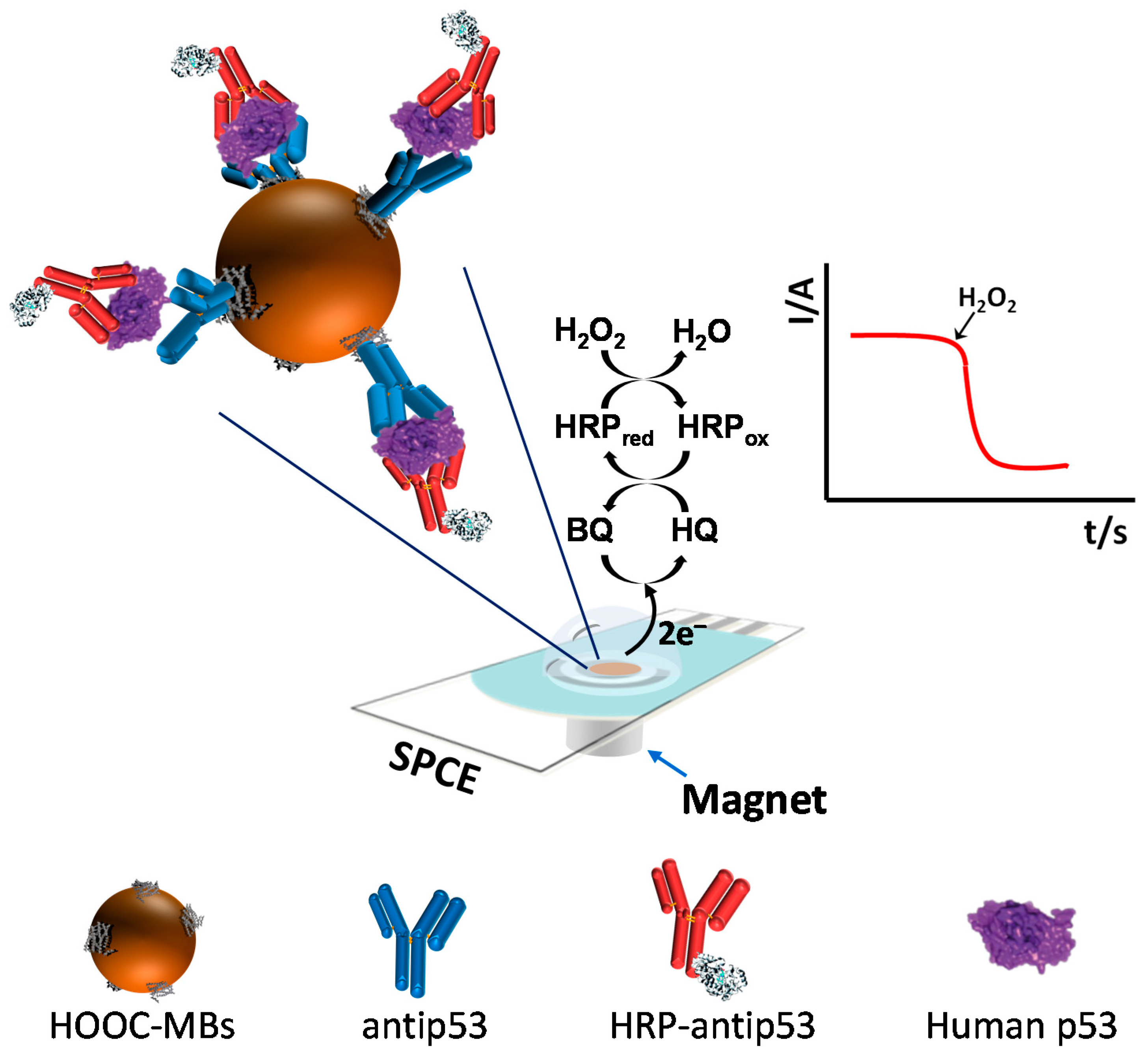
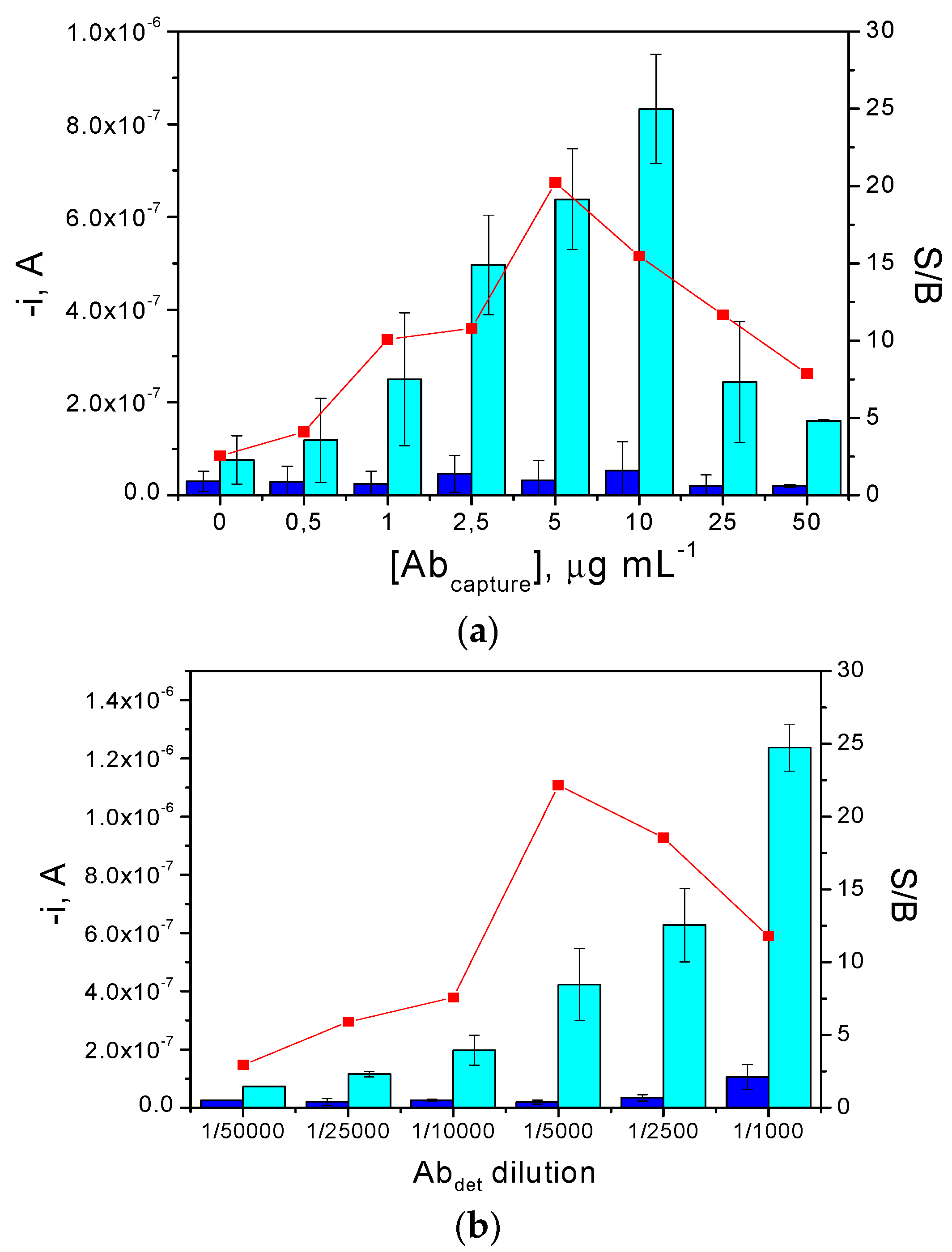
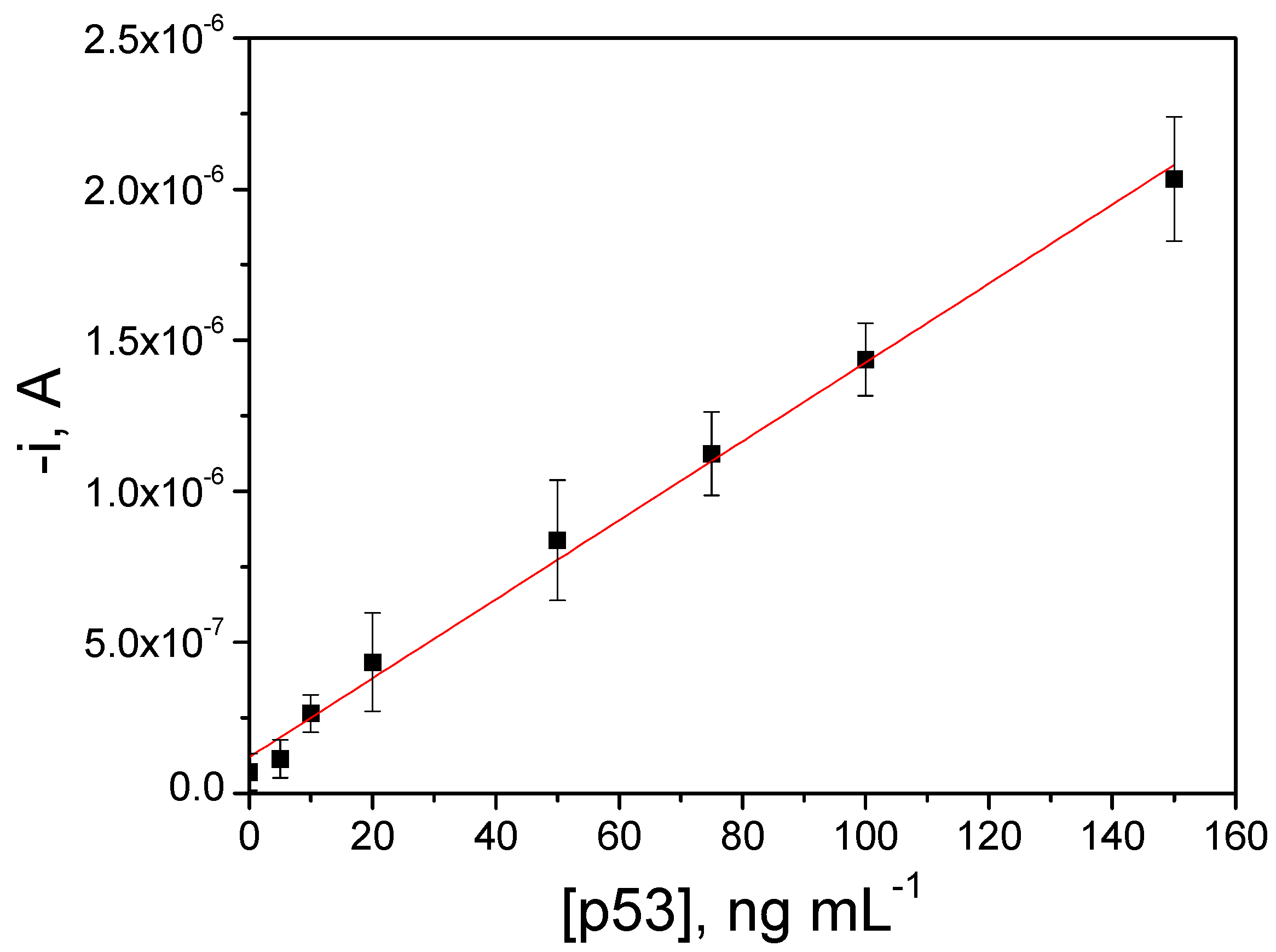
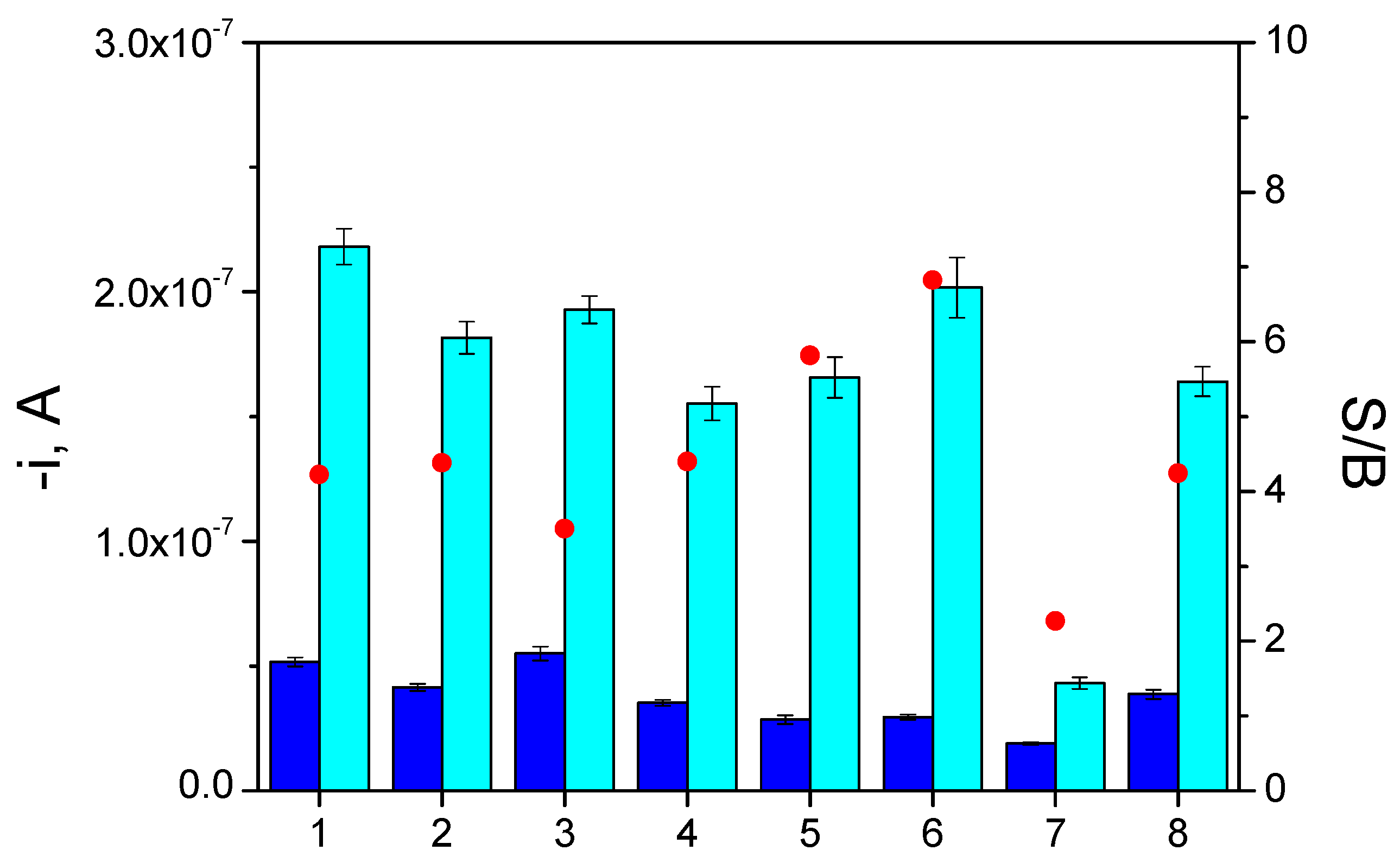
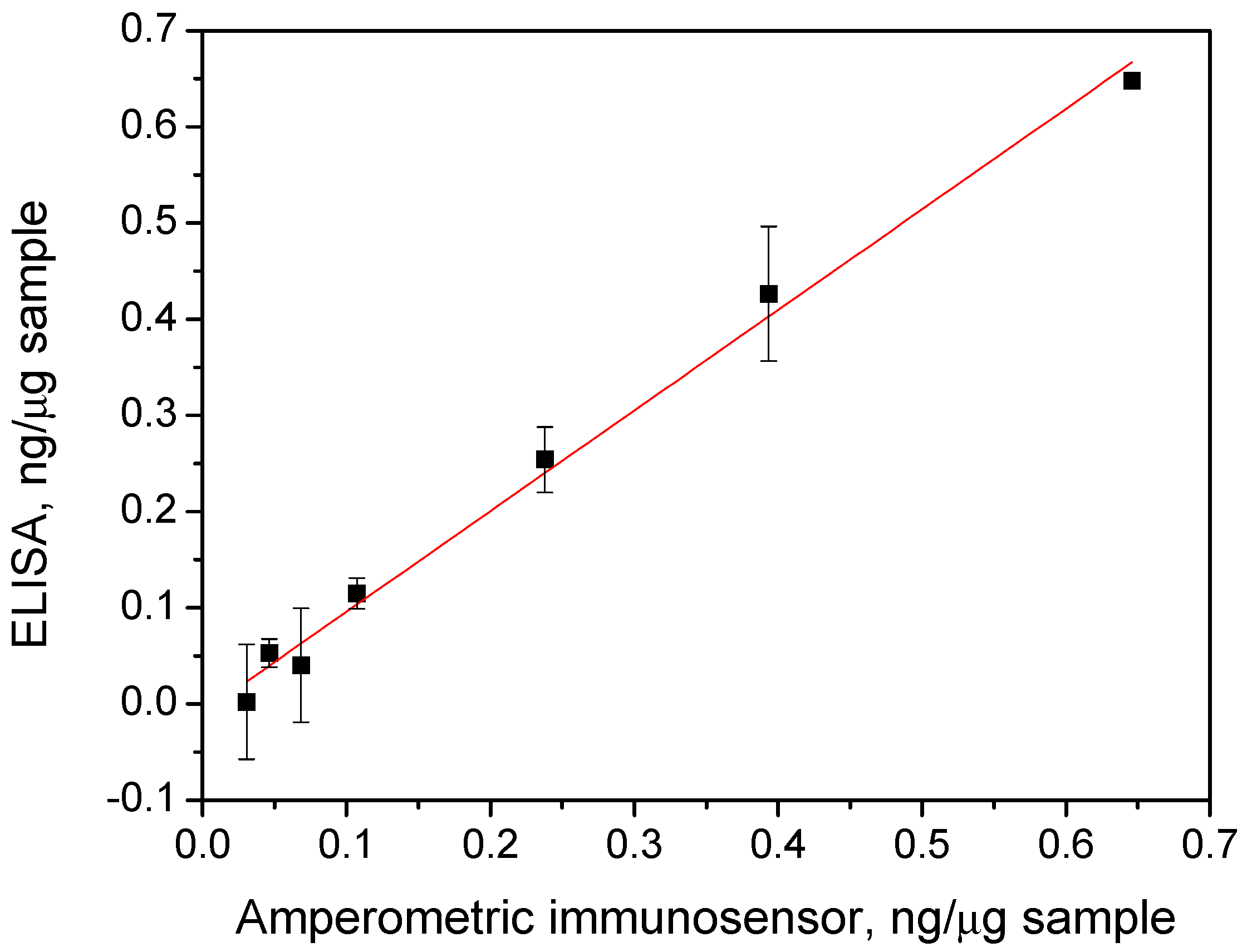
| Variable | Tested Range | Selected Value |
|---|---|---|
| VHOOC-MBs, µL | 1–6 | 3 |
| [AbC], µg·mL−1 | 0.0–50.0 | 5.0 |
| tincubation AbC, min | 0–90 | 30 |
| HRP-AbD dilution factor | 1/50,000–1/1000 | 1/5000 |
| tincubation HRP-AbC, min | 0–60 | 30 |
| tblocking ethanolamine, min | 0–60 | 15 |
| tblocking commercial blocker casein solution, min | 0–60 | 15 |
| Steps number | 1–2 | 1 |
| Working Electrode | Detector Antibody Labelling | Transduction Technique | Sample | Concentration Range | LOD | Preparation Time * | Assay Time ** | Reference |
|---|---|---|---|---|---|---|---|---|
| Graphene-chitosan-SPCE | HRP-streptavidin-biotin | DPV | - | 0.2–10 ng·mL−1 | 0.1 ng·mL−1 | ~4 h | ~2 h | [9] |
| AuNPs-SPCE | HRP-GO | SWV | Spiked human plasma | 0.02–2 nM | 0.01 nM | >4 h | >2 h | [7] |
| NHS-SPGE | HRP-Au nanorods | SWV | - | 0.01–20 nM (phospho-p53392) 0.05–20 nM (phospho-p5315) 0.1–50 nM (phospho-p5346) 0.05–20 nM (total p53) | 5 pM (phospho-p53392) 20 pM (phospho-p5315) 30 pM (phospho-p5346) 10 pM (total p53) | >4 h | ~5 min | [8] |
| Bi-SPCE | PCN-NS | SWV | Human serum | 0.02–20 ng·mL−1 | 0.01 ng·mL−1 | ~3 h | ~1.5 h | [14] |
| Thiolated GO-streptavidin-AuNPs-GCE | Avidin-biotin-HRP | DPV | Cell lysates. Normal and cancerous human skin fibroblast cells | 0.2–2 pM | 30 fM | ~20 h | ~3 h | [4] |
| SPCE | HRP | Amperometry | Cell lysates | 5–150 ng·mL−1 (69 nM–2.1 µM) | 1.29 ng·mL−1 (18 nM) | ~2 h | ~45 min | This work |
© 2016 by the authors; licensee MDPI, Basel, Switzerland. This article is an open access article distributed under the terms and conditions of the Creative Commons Attribution (CC-BY) license (http://creativecommons.org/licenses/by/4.0/).
Share and Cite
Pedrero, M.; Manuel de Villena, F.J.; Muñoz-San Martín, C.; Campuzano, S.; Garranzo-Asensio, M.; Barderas, R.; Pingarrón, J.M. Disposable Amperometric Immunosensor for the Determination of Human P53 Protein in Cell Lysates Using Magnetic Micro-Carriers. Biosensors 2016, 6, 56. https://doi.org/10.3390/bios6040056
Pedrero M, Manuel de Villena FJ, Muñoz-San Martín C, Campuzano S, Garranzo-Asensio M, Barderas R, Pingarrón JM. Disposable Amperometric Immunosensor for the Determination of Human P53 Protein in Cell Lysates Using Magnetic Micro-Carriers. Biosensors. 2016; 6(4):56. https://doi.org/10.3390/bios6040056
Chicago/Turabian StylePedrero, María, F. Javier Manuel de Villena, Cristina Muñoz-San Martín, Susana Campuzano, María Garranzo-Asensio, Rodrigo Barderas, and José M. Pingarrón. 2016. "Disposable Amperometric Immunosensor for the Determination of Human P53 Protein in Cell Lysates Using Magnetic Micro-Carriers" Biosensors 6, no. 4: 56. https://doi.org/10.3390/bios6040056







